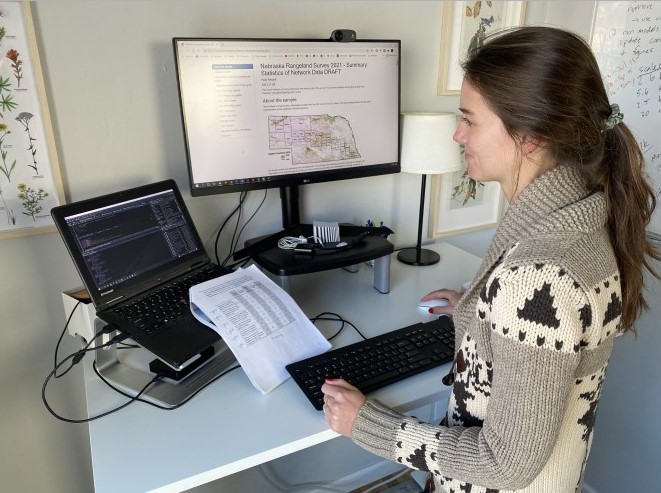
For Nebraska ranchers, it pays to network.
At least that is one preliminary finding of Nebraska-Montana EPSCoR student Holly Nesbitt. She is researching whether Nebraska ranchers can adapt to changes in land, like red cedars turning grasslands into woodlands, and how their social networks might affect that ability to adapt.
A Montana doctoral student, Nesbitt worked with Nebraska doctoral student Sabrina Gulab in surveying 4,500 Nebraska ranchers about landscape changes and a new technology capable of screening for such changes.
The technology, resilience informatics, shows where harmful changes in vegetation, like the spread of red cedar trees, are occurring in the United States. Ranchers can use the Rangeland Analysis Platform to see what may be coming their way and take action to prevent it.
Nesbitt has been looking at actions ranchers take against vegetation change. She is particularly interested in whether they use traditional methods, such as mechanical removal and use of chemicals, or methods newer to ranchers, such as prescribed burns and rotational grazing, and why.
“It seems as though the people are innovating by who is in their network, and that information is sort of spreading through their network and influencing whether or not they do those kinds of behaviors,” she said. “This is all very preliminary, but that’s what we’re seeing.”
In the survey, Nesbitt asked ranchers questions about their social networks, like how large their network was, what kinds of occupations people in their network held and how often the ranchers were in contact with others in their network.
“It seems like what our early results are saying is that social networks have a pretty big influence on behaviors that are newer, so on prescribed burning and rotational grazing,” Nesbitt said. “They appear less important for behaviors that everybody already does, like spraying chemicals. You could have a really tiny network, or you could have a really well-connected, large network. It doesn't matter because people spray chemicals regardless.”
Nesbitt noted she found it interesting that one social network variable--the density of a rancher’s network--appeared to negatively predict rotational grazing.
“What that means is that people who had more densely connected networks were less likely to use rotational grazing as a method for managing vegetation transitions,” she said. “That might not seem like it makes sense, but a lot of the research on social networks says that people who have really dense networks are actually more constrained in their behavior because they are so well connected with everybody that everything just stays in place, behavior doesn’t necessarily change as much, and innovation doesn't necessarily happen as much.”
Social networks are just one part of a rancher’s adaptive capacity, which Nesbitt defined as “the ability to be able to respond to or drive change.” Examples of other parts she looked at are the rancher’s power and ability to act, flexibility, assets, learning, and beliefs, attitudes and social norms.
She said the EPSCoR team has been interested in seeing whether ranchers who might be considered adaptive show that adaptiveness in the way they manage their land.
“If we can really firmly say that social networks are having this influence, then it's kind of interesting for extension professionals, agencies and nonprofits to think about how they connect with rancher and farmer networks,” she said.
Craig Allen, director of the Nebraska-Montana EPSCoR, said Nesbitt’s research sets a strong base on which the EPSCoR team and others can build.
“Her research informs us how to communicate to ranchers about the new technology of resilience informatics so that the maximum number can benefit from this freely available technology in anticipating and addressing harmful changes in vegetation,” Allen said.
Nesbitt said she and Gulab have also drafted a similar survey about cheatgrass for use in Montana with conservation professionals.
“It’ll be looking at adaptive capacity at the community or regional level,” she said. “I’m excited to see what comes out of that, so that’s all I will add is a teaser for that.”
— Ronica Stromberg, Nebraska-Montana EPSCoR Program Coordinator